Solar eclipse of October 4, 2089
| Solar eclipse of October 4, 2089 | |
|---|---|
| Type of eclipse | |
| Nature | Total |
| Gamma | 0.2167 |
| Magnitude | 1.0333 |
| Maximum eclipse | |
| Duration | 194 s (3 min 14 s) |
| Coordinates | 7°24′N 162°48′E / 7.4°N 162.8°E |
| Max. width of band | 115 km (71 mi) |
| Times (UTC) | |
| Greatest eclipse | 1:15:23 |
| References | |
| Saros | 145 (26 of 77) |
| Catalog # (SE5000) | 9709 |
A total solar eclipse will occur on October 4, 2089. A solar eclipse occurs when the Moon passes between Earth and the Sun, thereby totally or partly obscuring the image of the Sun for a viewer on Earth. A total solar eclipse occurs when the Moon's apparent diameter is larger than the Sun's, blocking all direct sunlight, turning day into darkness. Totality occurs in a narrow path across Earth's surface, with the partial solar eclipse visible over a surrounding region thousands of kilometres wide. The tables below contain detailed predictions and additional information on the Total Solar Eclipse of 4 October 2089.
Gregorian Calendar: October 4, 2089
Julian Calendar: September 21, 2089
Saros: 145 (26/77)
Node: Ascending
Greatest Eclipse: 2089 October 04 at 01:13:26.4 UTC
Eclipse Magnitude: 1.03333
Eclipse Obscuration: 1.06777
Gamma: 0.21671
Ecliptic Conjunction: 2089 October 04 at 01:15:43.6 UTC
Equatorial Conjunction: 2089 October 04 at 01:06:16.2 UTC
Sun Right Ascension: 12h42m34.2s
Sun Declination: -04º34'29.0"
Sun Diameter: 1918.2 arcseconds
Sun Equatorial Horizontal Parallax: 0º00'08.8"
Moon Right Ascension: 12h42m49.6s
Moon Declination: -04º22'10.5"
Moon Diameter: 1950.0 arcseconds
Moon Equatorial Horizontal Parallax: 0º59'38.5"
Delta T: 1 minute, 56.8 seconds
Related eclipses
Solar eclipses 2087–2090
This eclipse is a member of a semester series. An eclipse in a semester series of solar eclipses repeats approximately every 177 days and 4 hours (a semester) at alternating nodes of the Moon's orbit.[1]
The partial solar eclipse on June 1, 2087 occurs in the previous lunar year eclipse set.
| Solar eclipse series sets from 2087 to 2090 | ||||||
|---|---|---|---|---|---|---|
| Descending node | Ascending node | |||||
| Saros | Map | Gamma | Saros | Map | Gamma | |
| 120 | May 2, 2087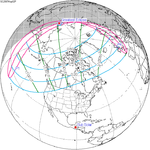 Partial |
1.1139 | 125 | October 26, 2087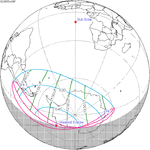 Partial |
−1.2882 | |
| 130 | April 21, 2088 Total |
0.4135 | 135 | October 14, 2088 Annular |
−0.5349 | |
| 140 | April 10, 2089 Annular |
−0.3319 | 145 | October 4, 2089 Total |
0.2167 | |
| 150 | March 31, 2090 Partial |
−1.1028 | 155 | September 23, 2090 Total |
0.9157 | |
Saros series 145
This eclipse is a part of Saros series 145, repeating every 18 years, 11 days, and containing 77 events. The series started with a partial solar eclipse on January 4, 1639. It contains an annular eclipse on June 6, 1891; a hybrid eclipse on June 17, 1909; and total eclipses from June 29, 1927 through September 9, 2648. The series ends at member 77 as a partial eclipse on April 17, 3009. Its eclipses are tabulated in three columns; every third eclipse in the same column is one exeligmos apart, so they all cast shadows over approximately the same parts of the Earth.
The longest duration of annularity was produced by member 15 at 6 seconds (by default) on June 6, 1891, and the longest duration of totality will be produced by member 50 at 7 minutes, 12 seconds on June 25, 2522. All eclipses in this series occur at the Moon’s ascending node of orbit.[2]
| Series members 10–32 occur between 1801 and 2200: | ||
|---|---|---|
| 10 | 11 | 12 |
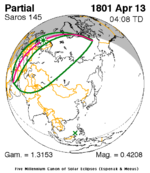 April 13, 1801 |
 April 24, 1819 |
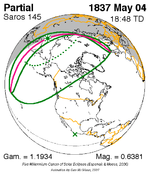 May 4, 1837 |
| 13 | 14 | 15 |
 May 16, 1855 |
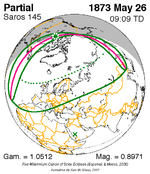 May 26, 1873 |
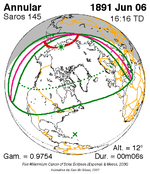 June 6, 1891 |
| 16 | 17 | 18 |
 June 17, 1909 |
 June 29, 1927 |
 July 9, 1945 |
| 19 | 20 | 21 |
 July 20, 1963 |
 July 31, 1981 |
 August 11, 1999 |
| 22 | 23 | 24 |
 August 21, 2017 |
 September 2, 2035 |
 September 12, 2053 |
| 25 | 26 | 27 |
 September 23, 2071 |
 October 4, 2089 |
 October 16, 2107 |
| 28 | 29 | 30 |
 October 26, 2125 |
 November 7, 2143 |
 November 17, 2161 |
| 31 | 32 | |
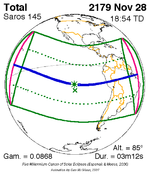 November 28, 2179 |
 December 9, 2197 | |
Tritos series
This eclipse is a part of a tritos cycle, repeating at alternating nodes every 135 synodic months (≈ 3986.63 days, or 11 years minus 1 month). Their appearance and longitude are irregular due to a lack of synchronization with the anomalistic month (period of perigee), but groupings of 3 tritos cycles (≈ 33 years minus 3 months) come close (≈ 434.044 anomalistic months), so eclipses are similar in these groupings.
| Series members between 1801 and 2200 | ||||
|---|---|---|---|---|
 December 21, 1805 (Saros 119) |
 November 19, 1816 (Saros 120) |
 October 20, 1827 (Saros 121) |
 September 18, 1838 (Saros 122) |
 August 18, 1849 (Saros 123) |
 July 18, 1860 (Saros 124) |
 June 18, 1871 (Saros 125) |
 May 17, 1882 (Saros 126) |
 April 16, 1893 (Saros 127) |
 March 17, 1904 (Saros 128) |
 February 14, 1915 (Saros 129) |
 January 14, 1926 (Saros 130) |
 December 13, 1936 (Saros 131) |
 November 12, 1947 (Saros 132) |
 October 12, 1958 (Saros 133) |
 September 11, 1969 (Saros 134) |
 August 10, 1980 (Saros 135) |
 July 11, 1991 (Saros 136) |
 June 10, 2002 (Saros 137) |
 May 10, 2013 (Saros 138) |
 April 8, 2024 (Saros 139) |
 March 9, 2035 (Saros 140) |
 February 5, 2046 (Saros 141) |
 January 5, 2057 (Saros 142) |
 December 6, 2067 (Saros 143) |
 November 4, 2078 (Saros 144) |
 October 4, 2089 (Saros 145) |
 September 4, 2100 (Saros 146) |
 August 4, 2111 (Saros 147) |
 July 4, 2122 (Saros 148) |
 June 3, 2133 (Saros 149) |
 May 3, 2144 (Saros 150) |
 April 2, 2155 (Saros 151) |
 March 2, 2166 (Saros 152) |
 January 29, 2177 (Saros 153) |
 December 29, 2187 (Saros 154) |
 November 28, 2198 (Saros 155) | |||
Notes
- ^ van Gent, R.H. "Solar- and Lunar-Eclipse Predictions from Antiquity to the Present". A Catalogue of Eclipse Cycles. Utrecht University. Retrieved 6 October 2018.
- ^ "NASA - Catalog of Solar Eclipses of Saros 145". eclipse.gsfc.nasa.gov.
References
- Earth visibility chart and eclipse statistics Eclipse Predictions by Fred Espenak, NASA/GSFC




